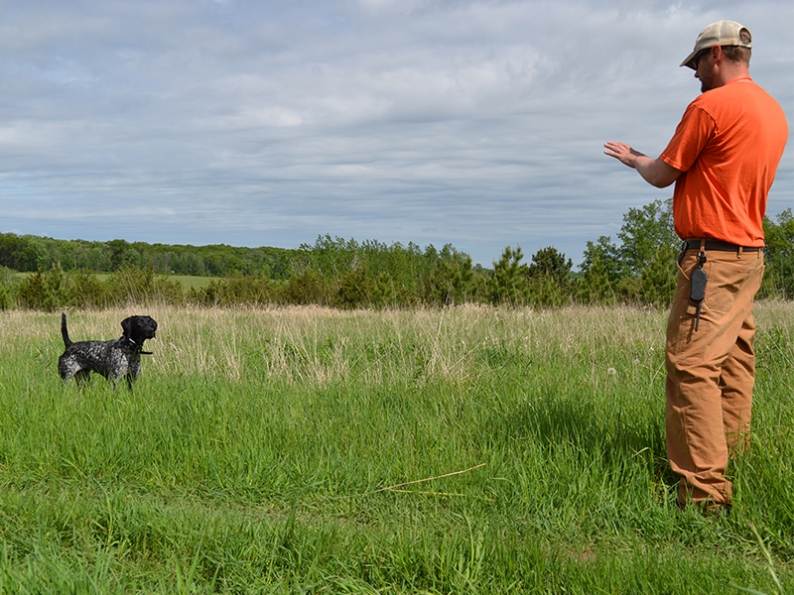
How do you keep your hunting dog sharp this offseason? Chad Hines, owner of Willow Creek Kennels and Hunting out of Little Falls, MN offers some insights from his proven and successful offseason training regimen. Chad is an accomplished dog trainer and breeder of registered German Shorthair Pointers but his insights are universal for all hunting breeds.
Conditioning your dog is key to effective training. Dogs that are not in good condition are prone to numbers of injuries that can cause setbacks. Healthy dogs not only train better but hunt better because stamina is important to hunting. Many dog owners walk or run with their dogs. “Roading” is an effective way many professional trainers exercise dogs for top physical conditioning throughout the year. Use a harness to hooked up the dog to a vehicle like a golf cart or UTV. Simply drive while the dogs run next to the vehicle. A quiet gravel road can work well along with any trail but stay away from pavement or concrete. Large in-shape dogs shouldn’t have an issue running 10+ miles a day. Like any training, ease into the repetition and work your dog progressively over time to A. Get your dog in shape and B. Keep your dog in shape.
Besides the cardio advantages, this training will naturally wear down the nails. Many large hunting breeds need this physical activity and will be not only be in better shape physically but also mentally as well. There is an old saying with dog draining, “a tired dog is a good dog."
Back to Basics-
Spring training is a perfect time to get back to basics. Trainer Chad Hines recommends lots of yard work with food rewards and positive reinforcement training. Bring out the place boards and work on the basics. Hines stresses the importance of taking small steps with your dog. Obedience and steadiness should be a top priority using positive reinforcement. Check cords should be incorporated with place board training for added control when necessary. In every training situation, the handler should make movements with the dog. Dogs are great learners and will pick up on body language. At times, no verbal communication is necessary when a dog knows what to do based on the human’s body language.
Preventing Gun Shyness
Gunfire conditioning can be delicate. Be creative, start with a small cap gun for a soft approach. Only display and fire a weapon around the dog directly before some form of reward. Step outside the vehicle where a dog can watch you raise and fire a cap gun then turn around and open the door for them to run around and play. Repetition of this will soon have a dog excited about the crack of a gun and eliminating shyness around gun fire.
Hunting Familiarity and Repetition
Embrace any hunting situation during the offseason that can get your dog field work. Trials and preserves create these field atmospheres. Pigeon hunting is an often-underappreciated activity that offers great sporting action for hunters as well as great work for hunting dogs during the off time of year when nothing else is in season. Like waterfowl, pigeon fields can be scouted and a simple blind setup with a few spinning wing decoys will make for some great shooting action at times. Keeping a dog sharp and conditioned for real live hunting situations should include training exercises that replicate those situations. Shooting a few pigeons in a field for a dog to mark and retrieve is great training exercise. Planting chukars, pigeons, pheasants or quail to create hunting situations is also great repetition for breaking up the training routine. “These training situations don’t necessarily have to be long or intense through the off season, just keep your dog exposed to the basics. Focus on obedience and conditioning and both you and your dog will have a much more memorable hunting season,” explains Hines.
More information on Chad Hines and Willow Creek Kennels can be found at:
http://www.willowcreekkennels.net/about-us/the-people/